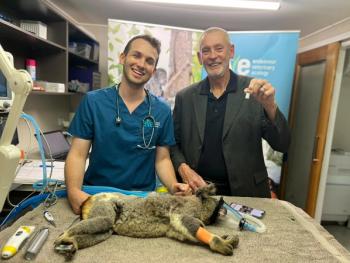
- dvm360 April 2023
- Volume 54
- Issue 4
- Pages: 57
“Vet shopping” is an alarming trend in opioid prescribing
Practices need to be aware of the signs and take action to minimize drug diversion
We are all aware of the tragedy that is the opioid crisis in the United States. Some staggering statistics reflect the extent to which this problem has worsened in recent decades: The number of opioid-related overdose deaths has quadrupled since 1999, and in 2019 alone there were nearly 50,000 such deaths across the nation.1
The total economic burden is estimated to be $78.5 billion a year, including the costs of health care, lost productivity, addiction treatment, and criminal justice involvement. Multiple factors have contributed to the growing misuse of and addiction to opioids, including aggressive marketing by pharmaceutical companies that denied or minimized the risk of addiction to the medical community2 and despair in communities where employment has declined or disappeared.3 The opioid crisis is a health crisis, an economic crisis, and a social crisis.
With changing laws and new criteria for physicians to prescribe opioid pain medications, drug seekers have become more creative in their efforts to obtain opioids. Veterinary clinics are a recognized source of controlled drugs used for analgesic, anesthetic, and other purposes. In the clinic setting, opioids can be diverted from their intended use by staff who illegally distribute or abuse them or by owners who obtain them from a veterinarian under false pretenses, a practice known as vet shopping. Although hard numbers are not available on how often this type of diversion happens, a 2018 survey of 189 Colorado veterinarians found that 44% were aware of opioid abuse or misuse by either a client or a hospital staffer, and 13% had discovered that an owner had intentionally injured or sickened a pet, or made it seem compromised, to obtain controlled drugs.4
A more recent study5 examined national opioid prescribing and reported alarming trends in what was likely vet shopping. The authors of this study queried IQVIA Longitudinal Prescription Data— which reports all prescriptions dispensed from 92% of US retail pharmacies and 70% of US mail order pharmacies—and extracted the number of patients with dispensed controlled substance prescriptions such as opioid analgesics, opioid cough and cold medications, and benzodiazepines from multiple veterinarians from 2014 through 2019. For every patient who had at least 1 such prescription from a veterinarian during a given year, the investigators determined how many veterinarians accounted for these controlled substance authorizations. A vet shopper was a patient with controlled substance prescriptions from 4 or more veterinarians, a metric that is analogous to a national quality measure used in human medicine.
Between 2014 and 2019, the number of patients with controlled substance prescriptions from 4 or more veterinarians increased from 935 to 2875—a gain of 207.5%. Although this number might seem small, it is important to remember that this population only reflects owners who filled the prescription at a pharmacy rather than a veterinary clinic and therefore likely underestimates the true incidence. However, given that a mean of 1,110,594 (SD, 104,109) controlled substance prescriptions from veterinarians were recorded annually during this period, the database captures a representative and clinically relevant number of dispensations.
In the study, tramadol accounted for the highest share of opioid analgesic prescriptions (92.6%), followed by codeine (2.9%) and hydrocodone (1.9%). Alprazolam and diazepam accounted for 73.5% and 19.8% of benzodiazepine prescriptions, respectively. Interestingly, the number of likely vet shoppers with opioid analgesic prescriptions declined slightly after 2016, whereas the corre- sponding number for opioid cough and cold medications rose 9-fold.
The decrease in opioid analgesic shopping could have occurred for a number of reasons. Remember the opioid shortage that occurred around that time? Veterinarians may have started increasing the use of nonopioid pain management in response. There was also evidence that emerged questioning the efficacy of tramadol for dogs,6 which might have led to fewer prescriptions for the drug overall. The dramatic increase in cough and cold medication prescriptions remains unexplained, and it is possible that less awareness by veterinarians of the potential for abuse of these drugs makes them a more effective target for vet shoppers.
The data presented in this study suggest that although vet shopping is still rare, this behavior may be increasingly common and more frequent than previously appreciated. Veterinarians should be aware of the possibility and be able to recognize a potential vet shopper.
According to the American Veterinary Medical Association, signs of a vet shopper include new clients bringing in seriously injured animals with vague histories or old, incomplete, or missing veterinary care records; describing clinical signs that are inconsistent with findings on examination of the patient or that require specific medications; requesting medications by name (eg, tramadol or alprazolam) or refusing medications as prescribed and suggesting alternatives; requesting early refills of medication or requesting refills while missing appointments; claiming medications were lost or stolen; and generally uncooperative and aggressive behavior.7
Being aware of these signs and minimizing drug diversion within the clinic by restricting access to and meticulously documenting the use of controlled substances are some of the ways veterinarians can combat the misuse of opioids.
Laurel Redding, VMD, PhD, DACVPM, is a veterinary epidemiologist with expertise in the epidemiology and transmission dynamics of microbes at the human/animal interface. She also has an interest in pharmacoepidemiology. Her research seeks to understand how animal contact affects the health of the gut microbiome and epidemiology of Clostridioides difficile infection in people, and promote antimicrobial stewardship in veterinary medicine by identifying effective stewardship interventions and formulating guidelines for antimicrobial use. Redding holds a VMD and PhD from the University of Pennsylvania and board certification from the American College of Veterinary Preventive Medicine.
References
- Hedegaard H, Miniño AM, Spencer MR, Warner M. Drug overdose deaths in the United States, 1999-2020. National Center for Health Statistics. December 2021. Accessed March 13, 2023. https://www.cdc.gov/nchs/data/databriefs/db428.pdf
- Hadland SE, Rivera-Aguirre A, Marshall BDL, CerdáM. Association of pharmaceutical industry marketing of opioid products with mortality from opioid-related overdoses. JAMA Netw Open. 2019;2(1):e186007. doi:10.1001/jamanetworkopen.2018.6007
- Beseran E, Pericàs JM, Cash-Gibson L, Ventura-Cots M, Porter KMP, Benach J. Deaths of despair: a scoping review on the social determinants of drug overdose, alcohol-related liver disease and suicide. Int J Environ Res Public Health. 2022;19(19):12395. doi:10.3390/ijerph191912395
- Mason DS, Tenney L, Hellyer PW, Newman LS. Prescription opioid epidemic: do veterinarians have a dog in the fight? Am J Public Health. 2018;108(9):1162-1163. doi:10.2105/AJPH.2018.304603
- Chua KP, Perrone J, Redding LE, Brummett CM, Bahl S, Bohnert AS. Trends in the number of patients linked to potential vet-shopping behavior in the United States (2014-2019). Am J Vet Res. 2022;83(2):147-152. doi:10.2460/ajvr.21.10.0173
- Budsberg SC, Torres BT, Kleine SA, Sandberg GS, Berjeski AK. Lack of effectiveness of tramadol hydrochloride for the treatment of pain and joint dysfunction in dogs with chronic osteoarthritis. J Am Vet Med Assoc. 2018;252(4):427-432. doi:10.2460/javma.252.4.427
- Vet shopping and drug diversion:a guide for veterinarians. American Veterinary Medical Association. Accessed February 8, 2023. https://www.avma.org/sites/default/files/2019-11/Opioids_Vet-Shopping-Drug-Diversion_Guide-for-Veterinarians_flyer.pdf
Articles in this issue
over 2 years ago
Cardinal rules for building effective communicationover 2 years ago
The veterinary practice operating systemover 2 years ago
D is for dental organizationsover 2 years ago
Uniting the front and back teamsover 2 years ago
Interdigital furunculosis: medical and surgical optionsover 2 years ago
Conscious clarity: The path to self-loveover 2 years ago
Oncology myths, part 2over 2 years ago
Veterinary supervisionover 2 years ago
Working together to maximize spectrum of careNewsletter
From exam room tips to practice management insights, get trusted veterinary news delivered straight to your inbox—subscribe to dvm360.






